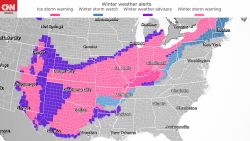US airlines canceled thousands more flights Thursday as a powerful winter storm packing ice, rain, sleet and several inches of snow is stretching from the Midwest to the South and eventually parts of the Northeast.
For Wednesday, Chicago O’Hare, a United and American Airlines hub, is the most affected airport with 364 cancellations, according to flight tracking site FlightAware. St. Louis, Denver and Detroit airports are also accumulating cancellations with 352 as of Wednesday night. In total, airlines have canceled 2,350 US flights Wednesday.
Thursday appears to be even worse, with FlightAware data showing US airlines have canceled at least 3,563 flights within, into, or out of the United States for that day. Nearly 90% of scheduled flights from Dallas Love Field, a Southwest hub, have already been canceled. The airline has already cut 26% of its schedule for Thursday. Dallas Fort Worth, another American Airlines hub, has 375 cancellations.
Airlines issue travel waivers letting flyers rebook for free when severe weather impacts operations. CNN Travel offers a guide on what to do if your flight is affected.
The storm system’s reach is so expansive that more than 100 million people across at least 25 states were under winter weather alerts as of early Thursday, from the Mexican border to New England. And some areas, including Texas, are expected to feel the impacts through Saturday afternoon.
Heavy snow began falling Tuesday and more than 20 inches had piled up in the Colorado Springs area, according to the National Weather Service. Parts of Illinois were inundated with more than a foot of snow, while Indiana had tallied more than 11 inches. That caused more than 2,300 flight cancellations across the US.
It’s been a miserable few weeks to be an airline traveler, especially after last weekend’s storm that complicated service. Winter weather and Omicron surges left 20,000 US flights canceled over the busy holiday travel season. As demand picked up, staffing cuts also left airlines with fewer employees than they had before the pandemic.

























